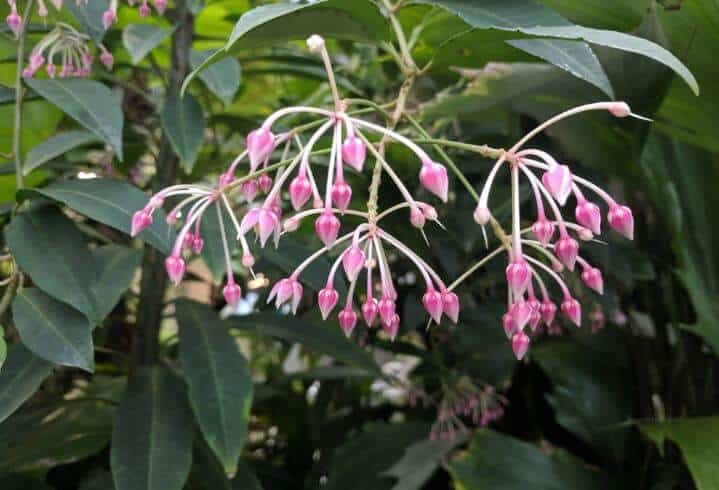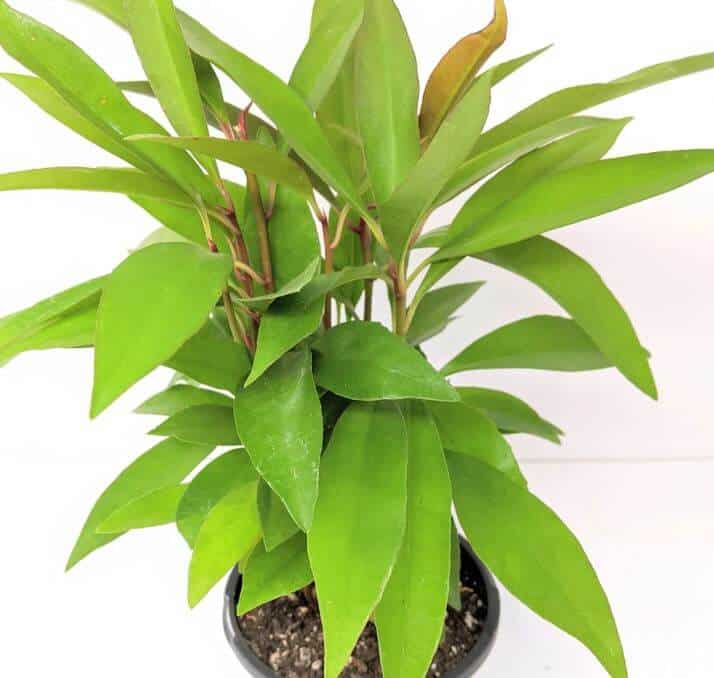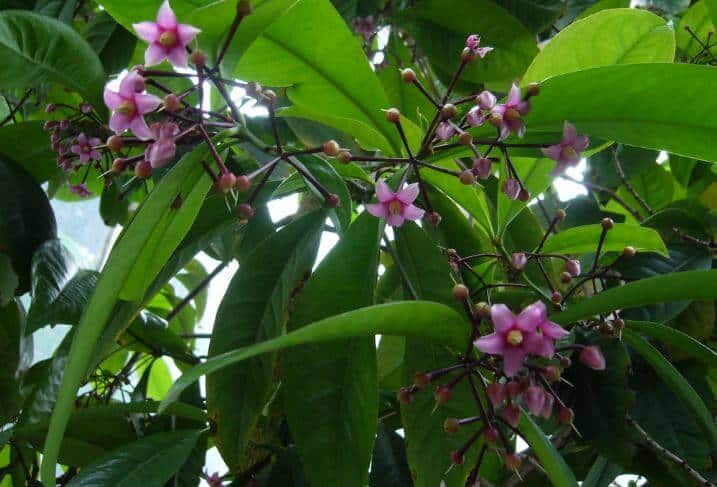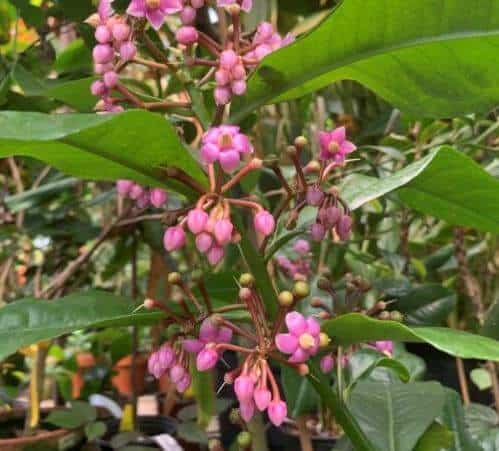Last Updated on February 27, 2023 by a Friendly Gardener
Consider the Low Shoe Button plant if you’re looking for an unusual houseplant to add a bit of life to an indoor space. A slow-growing cheery evergreen shrub, this houseplant looks great placed on a desk, table, or bureau. As your Ardisia matures, it will make a great floor plant.
Botanically known as the Ardisia Humilis, the Shoe Button plant belongs to the Primulaceae family and is the perfect houseplant. It is native to Southern China, Vietnam, and the Philippines.

It is known to tolerate low lighting conditions and erratic watering or occasional forgetfulness. Showy berries are its claim to fame, in fact, you may find it named the Jet Berry plant. For those who love vivid green foliage, this is a stunning addition with leathery leaves. It grows upright so that as it grows, you can transfer it to the floor.
Also appreciated are the plant’s flowers in a rose-lavender hue. Blossoms will appear on new growth from mid-spring throughout the growing season in summer. Once blooms are spent, rich red to purplish black berries will form in clusters in late autumn. Each berry contains a single seed.
This is a plant that can be limited to a manageable size thanks to its slow growth. When cultivated outdoors, it can be planted in partially shady areas.
Ardisia Humilis Houseplant Care

Ardisia plants in general, are almost self-sufficient especially when cultivated outdoors. When cultivated as a houseplant, keep these recommendations in mind.
Soil
Ardisia plants like well-draining soil beds, however, they are very adaptable and will tolerate various soil types including clay-based soil. The ideal soil blend will feature both drainage and water retention qualities. Soil mixes can be amended with compost for nutrients, coconut coir for drainage, and peat moss for water retention. Beware of too much moisture to avoid fungal infections. Compacted soil should be avoided, and good airflow should be guaranteed with efficacious drainage.
Your Ardisia will prefer slightly acidic soil (6.1to 6.5), so pH should mirror this. The plant genus does have an adaptable pH, so the plant will grow in slightly alkaline (7.6 to 7.8) or neutral (6.6 to 7.5) soils as well. A pH soil test kit can help you identify your soil’s pH.
Light

Bright indirect lighting is recommended for this plant and partial shade outside. A little sunlight through a window won’t do your plant any harm. If you live in a low-light space, consider supplementing with a grow light.
Water
Overwatering or underwatering can be a problem. If you water too little, the foliage may brown and turn crispy. If you water too much, you will expose your plant to an increased risk of root rot.
Ideally, the soil bed should be maintained evenly moistened at all times. Outside you can use a bit of mulch to aid water retention between your plant’s watering. If you are a new Ardisia plant parent, start by watering weekly. Check the soil moisture level daily, in the beginning, to see how long it takes for your plant’s soil bed to dry out. If the soil dries rapidly, increase the frequency of watering. Avoid allowing your plant to stand in a dish of water, as the soil risks becoming waterlogged. Dried-out soil can cause flower buds to drop off.
Humidity
A bit of humidity will help, as this plant will absorb some moisture from the surrounding air. The average humidity found in homes should be sufficient. If the air is very dry, especially from heating or air conditioning units, consider using a pebble tray or water-filled receptacle near the plant. You can add humidity when buds begin to form especially through misting with water at room temperature. Avoid spraying during flowering and berry production. When the room humidity id too low, your plant will produce fewer berries or those formed will crumble.
Temperature
The Ardisia will find itself right at home in average indoor temperatures measuring somewhere between 60° and 90°F, although 60° to 80° will be ideal. If you place it outdoors, it will need protection from extreme heat otherwise berries will dry out. It will also not tolerate temperatures lower than 45°F. and flowers should be protected from drafts or they will drop off.
Feeding
Ardisia plants are survivors, so even if you choose not to feed yours, it will be fine. However, to encourage your plant, a monthly feeding will help it thrive indoors. Limit feedings to the spring and summer months of the growing season. A balanced liquid houseplant fertilizer will work well.
Pruning

The Ardisia humilis should be pruned to maintain the shrub’s compact shape. Plan on pruning in the spring before annual flowering begins.
Repotting
If your plant is root bound, it’s time to repot. If not, you can wait a year. Choose a new pot that is one to two sizes larger. Remove the plant gently from its old pot as well as the old soil from the root ball. Repot with fresh soil that is well-draining. Cover the root system to the same height as before. Water thoroughly and allow all excess water to drain.
Ardisia Humilis Problems
Scales, aphids, and even worms can visit an Ardisia humilis, and this plant is susceptible to fungal infection. It also can suffer from chlorosis. In this case, it will need an iron supplement when fertilized. Spider mites may appear if the plant and environment are too dry. Clean with a spray of water and treat the Shoe Button plant with neem oil or insecticidal soap.
Yellow foliage indicates that the air is too dry or that the plant is suffering from a lack of nitrogen. Faded foliage, particularly in winter will alert you to a lack of light or may indicate chlorosis damage. Move your plant to a sunnier location or consider iron supplements. Leaf dropping can be due to irregular watering.
Brown tips and edges of foliage generally indicate that the humidity is too low. Consider using a space humidifier. Brown spots and specks on leaves may indicate bacterial infection. Remove all infected foliage and reevaluate the watering schedule.
Twisted leaves generally indicate that the environmental temperature is too cold.
Ardisia Humilis Propagation

Ardisia Humilis is generally propagated with seeds or cuttings. To propagate with seeds, sow them in January. You can harvest your own seeds from berries that reach approximately 10 mm in diameter. Remove fruit pulp. Seeds should undergo a bit of filling known as scarification and then be soaked in root hormones for a couple of hours.
Place the seeds approximately 10mm deep in moistened soil. Cover the container with plastic and position it in a warm spot. After approximately 40 days, seedlings should emerge. Transplant them into individual pots. These young plantlets will need about 2 years to develop into full-grown plants.
When using cuttings for propagation, trim a stem six to eight inches long from the parent plant. Foliage needs to be removed except for the leaves at the very top. Cover the cut end with root hormone and place it in a soil mix.
Ardisia Humilis Toxicity
The plant is suspected of being poisonous to humans and to family pets.

